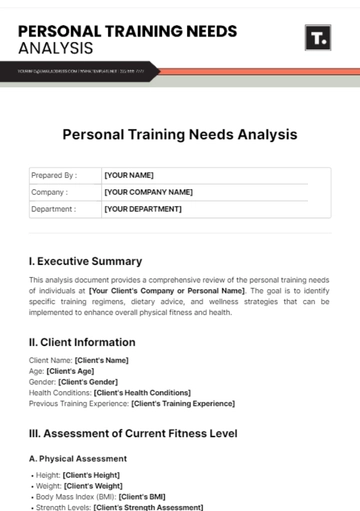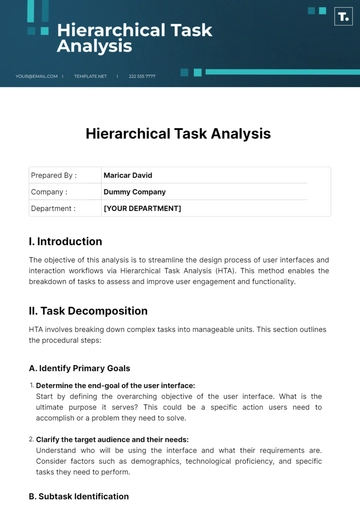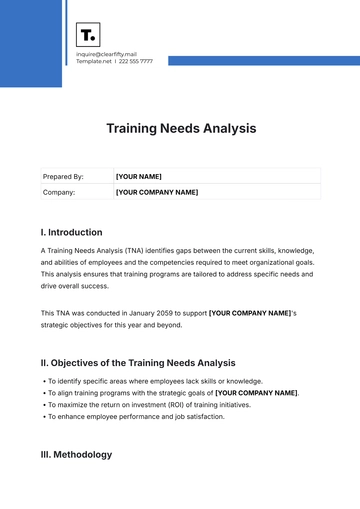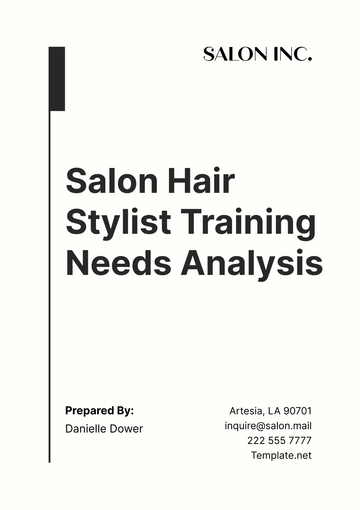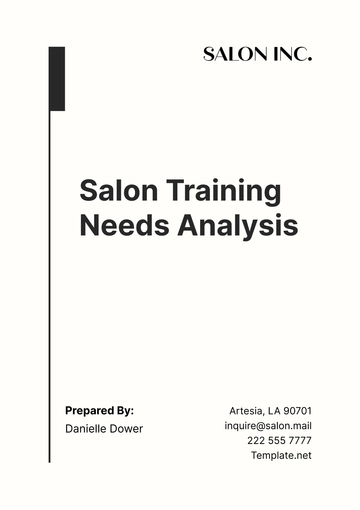Free Salon Training Needs Analysis
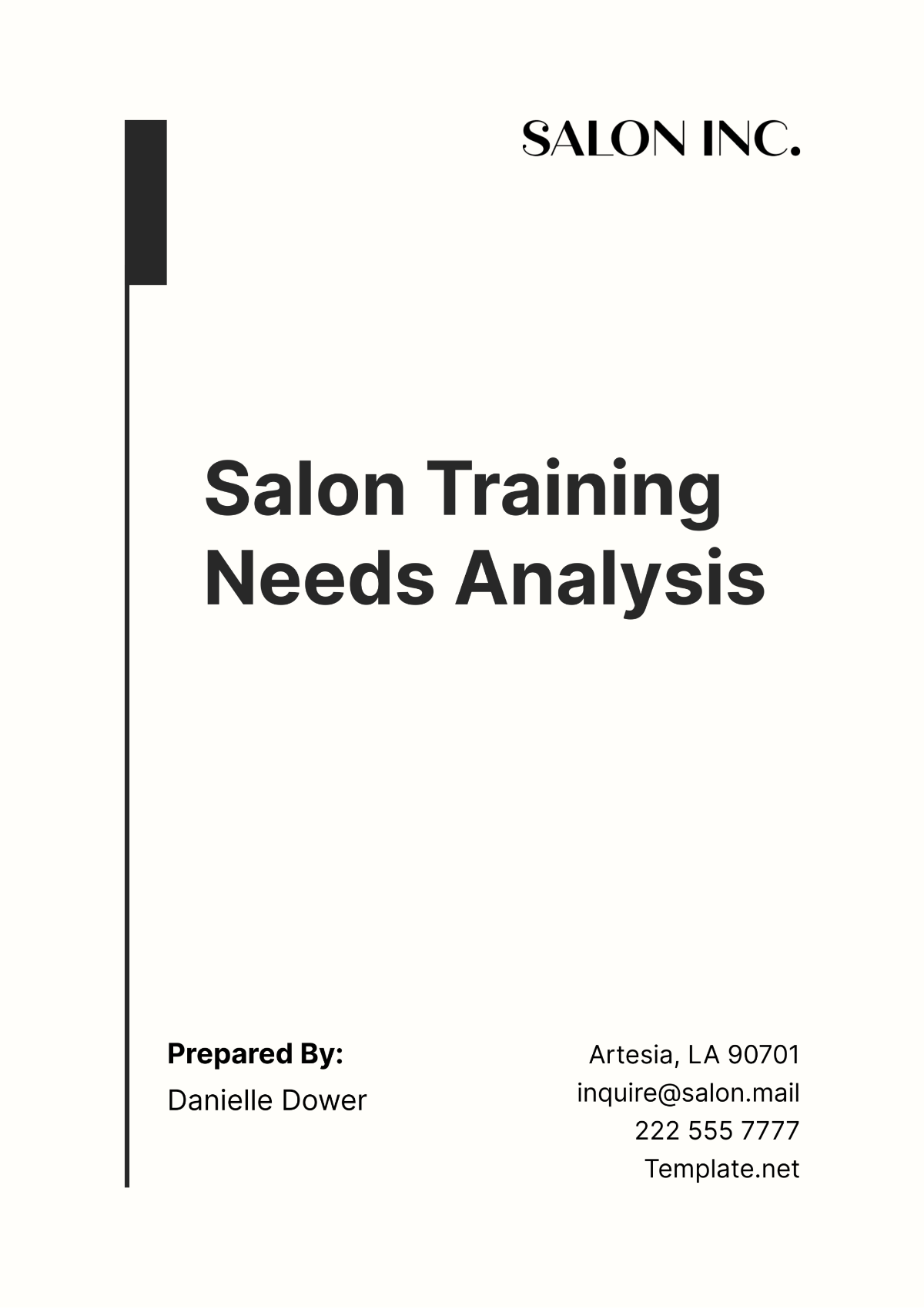
1. Introduction
In the dynamic and ever-evolving beauty and wellness industry, staying ahead of trends and technological advancements is crucial. This necessitates a commitment to continuous professional development and training within salons. At [Your Company Name], recognizing and addressing the training needs of our team is not just about maintaining competitiveness; it’s about leading the market in service quality and innovation. Our Salon Training Needs Analysis aims to critically evaluate the current training landscape, identify gaps in our team's knowledge and skills, and devise customized training paths to enhance proficiency and service delivery.
The goal is to cultivate a highly skilled team that exceeds customer expectations, thereby enhancing our salon's reputation and driving profitability. This analysis is designed to be a cornerstone for strategic workforce development, ensuring that our professionals are not only equipped to meet today's challenges but are also prepared for future industry shifts.
Objectives:
Skill Enhancement: To update and refine the professional skills of our staff in line with the latest industry practices.
Service Innovation: To enable our team to introduce and proficiently deliver new services that meet evolving customer preferences.
Quality Assurance: To ensure that every client interaction is distinguished by expert service delivery, enhancing customer satisfaction and loyalty.
2. Methodology
Our approach to this comprehensive analysis incorporates a blend of quantitative and qualitative research methods, ensuring a balanced and thorough understanding of our training needs. Conducted over a three-month period, this methodology involves direct inputs from a diverse cross-section of salon personnel and management.
Data Collection:
Surveys: We distributed detailed surveys to 150 salon professionals and 50 salon managers across [Your Company Name] locations in [Name of Locations]. These surveys were designed to assess satisfaction with current training programs and to pinpoint areas where additional training is desired or necessary.
Interviews: In-depth interviews were held with a selected group of salon professionals and managers to gather more nuanced insights into the specific training needs and the effectiveness of existing training initiatives.
Observations: Our team conducted structured observations within salons to directly assess how staff manage and execute various services, particularly focusing on areas where lapses in skill or knowledge were apparent.
Selection Rationale:
Participants were selected based on their roles, experience levels, and direct interaction with clients to ensure a comprehensive view of our operational needs and opportunities. This diverse input helps tailor our training programs to be as effective and inclusive as possible.
Analytical Techniques:
The quantitative data from surveys were analyzed to identify common themes and statistically significant trends.
Qualitative data from interviews and observations were critically assessed to form a narrative around existing capabilities and gaps.
3. Key Findings
Technical Skill Gaps:
A significant proportion of mid-tier stylists displayed a notable deficiency in advanced cutting techniques, which are crucial for attracting a higher-end clientele.
There is a growing demand for sustainable beauty products, yet our staff's current knowledge of these products and their benefits is limited, representing a missed opportunity in market differentiation.
Treatments for ethnic and textured hair are increasingly popular, but poor execution has been noted, suggesting a need for specialized training in this area.
Customer Service Shortcomings:
Observations indicated inconsistent levels of engagement with customers during services, which could impact client satisfaction and retention.
Staff confidence in handling customer complaints was generally low, pointing to a gap in training related to communication and problem-solving skills.
Business Management Needs:
Our analysis revealed a minimal understanding among staff regarding the use of digital marketing strategies, which are essential for attracting new clientele in the digital age.
There was also limited proficiency in utilizing advanced features of our salon management software, which could streamline operations and enhance customer service.
These findings indicate critical areas where targeted training could significantly enhance service quality, operational efficiency, and customer satisfaction at [Your Company Name]. The next sections will further dissect these insights and propose actionable strategies to address the identified gaps, ensuring that our salon remains at the forefront of industry standards and customer expectations.
4. Insights from the Data
The collected data provides a detailed look into the specific training needs within [Your Company Name]. Below is an enhanced table that categorizes these needs by professional area, identifies the issues, and shows the percentage of professionals affected:
Table: Detailed Analysis of Identified Training Needs
Category | Issue Identified | Percentage Affected |
|---|---|---|
Technical Skills | Advanced Cutting Techniques | 75% |
Sustainable Beauty Products | 60% | |
Ethnic and Textured Hair Treatments | 70% | |
Customer Service | Engagement During Service | 85% |
Handling Customer Complaints | 80% | |
Business Management | Digital Marketing Strategies | 65% |
Salon Management Software Usage | 75% |
Discussion of Insights:
Technical Skills: The high percentage of stylists needing advanced training in cutting techniques and ethnic hair treatments highlights a critical gap that could be limiting service offerings and customer satisfaction.
Customer Service: The lack of engagement and difficulty in handling complaints point to a need for enhanced communication training, which could significantly impact customer retention.
Business Management: The gaps in digital marketing and software usage suggest a potential weakness in business operations, which could be streamlined through targeted technology training.
5. Actionable Recommendations
Based on the insights derived from the analysis, several strategic recommendations can be made to address the training deficiencies:
Quarterly Training Programs: Initiate structured quarterly training sessions focusing on:
New Hair Treatment Techniques: Specifically for advanced cutting and ethnic hair treatments.
Product Knowledge: With a focus on sustainable beauty products to meet growing consumer demand.
Customer Service Excellence: Enhance skills in customer engagement and complaint management.
Digital Tools and Software Training: Implement regular training sessions on the effective use of digital marketing tools and salon management software. This will not only improve operational efficiency but also empower the salon to better promote its services.
Expert-Led Workshops: Arrange for industry experts to conduct workshops on the latest trends such as balayage techniques and eco-friendly treatments. These workshops can serve as both skill enhancement and motivational events for staff.
6. Conclusion
The Salon Training Needs Analysis clearly highlights significant gaps in technical skills, customer service, and business management across [Your Company Name]. Addressing these gaps through a structured and continuous training program is essential for maintaining competitiveness and enhancing service quality. Implementing the recommended training interventions will not only improve staff proficiency but also enhance overall client satisfaction and loyalty, fostering sustained business growth.
Appendix
Appendix A: Survey Instruments - Copies of the surveys used in this study, detailing both the questions asked and the scale of responses.
Appendix B: Interview Guidelines - The structured interview guidelines that were employed to gather detailed feedback from staff and managers.
Appendix C: Observation Checklist - The checklist used during in-salon observations to consistently record relevant data.
Case Study Table: Impact of Training on Business Outcomes
Training Implemented | Improvement in Service Quality | Increase in Customer Retention | Revenue Growth |
|---|---|---|---|
Advanced Cutting Techniques | 40% improvement noted | 20% increase | 15% increase |
Digital Marketing Training | N/A | 25% increase | 20% increase |
Customer Service Workshops | 30% improvement noted | 30% increase | 10% increase |
This case study table provides a snapshot of how similar training programs have positively impacted service quality, customer retention, and revenue growth in other salons, serving as a powerful motivator for adopting the recommended strategies within [Your Company Name].
- 100% Customizable, free editor
- Access 1 Million+ Templates, photo’s & graphics
- Download or share as a template
- Click and replace photos, graphics, text, backgrounds
- Resize, crop, AI write & more
- Access advanced editor
Discover Template.net's innovative Salon Training Needs Analysis Template, meticulously designed for salon owners and managers. Identify staff training requirements with precision and ease using our customizable template. Tailor every aspect to align with your salon's unique needs seamlessly. Utilize our intuitive AI editor tool for effortless editing and customization. Elevate your salon's training program effectiveness with Template.net.



